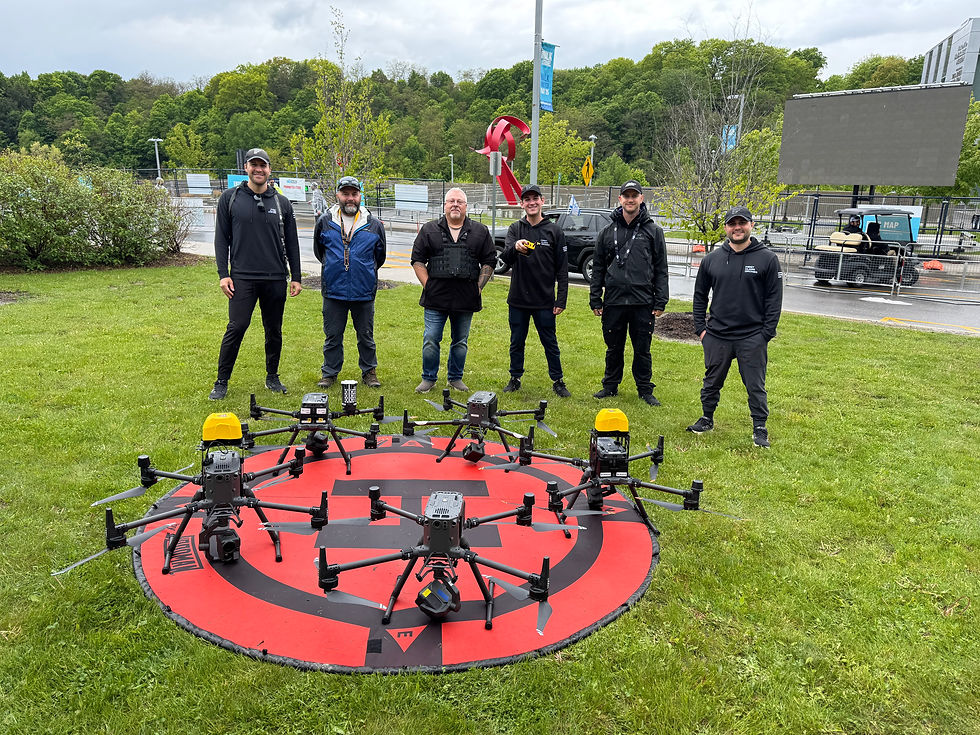Behind the Scenes... Aerial Cinematography for ESPN All Star Game Commercial
- Misha Herschorn

- Apr 22
- 4 min read
When ESPN called on First Class Drones to capture aerial footage for their All Star Game commercial, they weren’t just asking for beautiful drone shots, they were asking us to operate in very tough conditions.
The brief? Film the Toronto skyline at both sunrise and sunset, in sub zero temperatures, with high winds, from a moving boat, within the restricted airspace of Billy Bishop Airport.
No problem.
In this blog, we’re pulling back the curtain on how we pulled off one of the most challenging and visually rewarding shoots we’ve ever done. We’ll also break down how to safely launch and land a drone from a moving boat, for those of you ready to take your skills to the next level.

The Mission: Aerial Cinematography for ESPN All Star Game Commercial
The Challenge
We were tasked with capturing golden hour drone footage of downtown Toronto right next to an active airport.
Here is what we faced:
Temperatures well below freezing
Strong winds
No launch points from land
The clock ticking down to sunrise or sunset
Timing shots perfectly with airplanes flying across the skyline
This wasn't just about flying a drone, it was about engineering a solution and using our aerial cinematography skills to capture the best shots.
How We Pulled It Off
Step 1: Rent a Boat
To get the perfect vantage point of Toronto’s skyline across the water, we worked with production to charter a boat. It became our floating launch pad, camera platform, and warming station (barely).
Step 2: We Built a Custom Battery Heater
Batteries drain fast in freezing weather. We engineered a custom insulated heater to keep batteries at safe operating temperature before flight.
Step 3: Coordinated with Billy Bishop Airport
Operating within the controlled airspace of an international airport is no joke. We secured permissions, coordinated with air traffic control, and kept a dedicated aviation radio on deck for real time updates. Safety was priority number one.
Step 4 : Takeoff from a Moving Boat
This is where things got real and where experience matters most. Taking off and landing from a constantly shifting, wind blasted deck is no small feat. More on this below.
How to Launch and Land a Drone from a Boat
If you’re ever called on to do what we did, whether it’s for a film, a real estate project, or a personal adventure, here’s how to pull it off like a pro:
Pre-Flight Planning is Everything
Before you even step foot on the boat, map out your flight zones, check weather conditions, plan for communication with the crew, and if necessary, coordinate with any nearby air traffic authorities. In addition, calibrate the compass on the drone before getting onto the boat.
Choose the Right Boat
You want a boat with a stable, open deck and as little metal interference as possible. We positioned ourselves for the cleanest view and most stable ride possible. A good captain helps as well!
Battery Management in Cold Weather
Keep your batteries warm until just before flight. Our custom heater made all the difference, but in lighter setups, even hand warmers in an insulated bag can help.
Takeoff: Surface or Hand Launch
For larger drones with sufficient clearance, a surface launch from the boat deck is doable with teamwork. For smaller drones, a hand launch into the wind is usually safer. The key is to position the boat so that if the drone goes rogue, it will not hit the boat. We took off from the front of the boat, with the wind at our backs so that if the drone decided to fly away, it would do so away from the boat. We used a combination of hand launching and ground launching for this. The stability of the boat at launch played a crucial role in choosing the right technique for launch. If all else fails and you are getting a compass error on the drone, get that drone as high as possible away from the steel on the boat or switch into ATTI mode for takeoff.
Hover and Check Systems
Let the drone hover for a few seconds post takeoff. Confirm stable GPS, video feed, and compass data. If something feels off, land right away!
Landing: Precision or Hand Catch
Hand-catching was the safest option for us given the limited deck space and boat motion. One team member (in gloves) caught the drone from beneath while the pilot brought it in slowly and steadily.
Pro Tip: Disable Return to Home or manually reset the Home Point. You don’t want your drone trying to return to a boat that’s moved.
The Results: Freezing, Fierce, and Fantastic
Despite the cold, the wind, and the technical demands, the footage we captured was pure gold. The planes ascending in perfect rhythm in the foreground. The icy water gently moving in the background.
It was exactly what ESPN had envisioned and we were proud to deliver it. See one of the final shots below.
Final Thoughts: Creativity Takes Flight When Preparation Meets Precision
Flying a drone from a moving boat in freezing temperatures near an airport isn’t for the faint of heart. But for First Class Drones, it’s just another day on the job. With the right preparation, coordination, and creativity, even the most extreme shoots become not only possible but unforgettable.
If you're dreaming up something ambitious, whether it's a high stakes commercial or a unique location that seems impossible to film, we’d love to help make it fly.




Comments